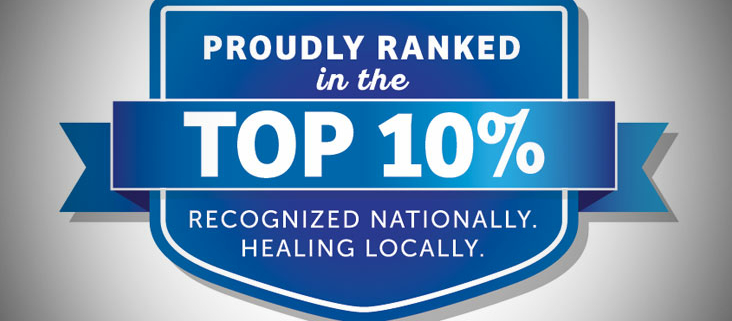Rehabilitation Hospital of the Northwest has been named in the Top 10 percent of inpatient rehabilitation facilities in the United States for the 4th year in a row. The hospital’s care was cited as being as being patient-centered, effective, efficient and timely.
“We strive to deliver this higher level of care as our standard,” says Jennie Pipoly, Chief Operating Officer, Rehabilitation Hospital of the Northwest. “We have graciously been recognized as a top performing facility for many years now, but we never take it for granted.”
“Our staff is exceptionally passionate about helping patients reach their full potential through the care we provide,” says Maureen Fakinos, Interim CEO and Senior Vice-President of Operations. “We work daily to ensure patients are reaching their highest levels of ability and independence.”
Rehabilitation Hospital of the Northwest was ranked in the Top 10 percent from among 870 inpatient rehabilitation facilities nationwide by the Uniform Data System for Medical Rehabilitation (UDSMR), a non-profit corporation that was developed with support from the U.S. Department of Education, National Institute on Disability and Rehabilitation Research. The UDSMR maintains the world’s largest database of rehabilitation outcomes.
“If you take into account that a national study has previously shown that inpatient rehabilitation facilities provide better long-term results for patients, being ranked at the top of that group validates the quality of care we provide,” says Dr. Steve Foster, Associate Medical Director for Rehabilitation Hospital of the Northwest, referencing a study commissioned by the ARA Research Institute that showed patients treated in inpatient facilities experienced improved quality of life as compared to skilled nursing facilities.
“To provide the highest level of rehabilitative care available to our own community is truly rewarding,” says Dr. David Duba, a physical medicine and rehabilitation physician at the hospital. “This means our family, friends, and colleagues don’t need to leave the area to receive this level of care.”
Through the UDSMR, Rehabilitation Hospital of the Northwest also will collaborate with peers throughout the nation to share information and establish best practices for patients. “This helps elevate rehabilitative care for everyone across the United States,” Duba says.
Rehabilitation Hospital of the Northwest provides specialized rehabilitative services to patients who are recovering from or living with disabilities caused by injuries, illnesses, or chronic medical conditions. This includes, but is not limited to, strokes, brain injuries, spinal cord injuries, orthopedic injuries, cerebral palsy, ALS (Lou Gehrig’s Disease), multiple sclerosis, and Parkinson’s disease.





